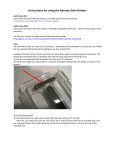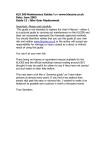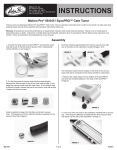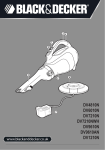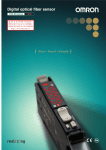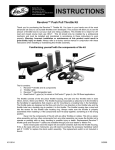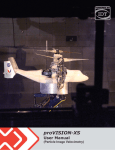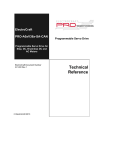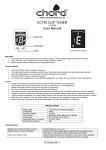Download KLX300 Fitting a Mikuni TM33-8012 Carb 1675KB Feb 23 2011
Transcript
KLX 300 Maintenance Guides from www.klxzone.co.uk Date: March 2003 Guide 10 : Fitting a Mikuni TM33-8012 Carb to the KLX Important: Please read carefully This guide is not intended to replace the User’s Manual – rather it is a pictorial guide to carrying out maintenance on the KLX300 and does not necessarily represent the Kawasaki approved methods. You should therefore realise that you use this guide at your own risk and neither www.klxzone.co.uk or the author will accept any responsibility for damage or injury caused as a direct or indirect result of using this guide. You use it at your own risk. There being no Haynes or equivalent manual available for the KLX300 and the official workshop manual costing around £60 I thought it may be useful for others to use if they have not carried out such tasks on their bike before. This may seem a bit like a “dummys guide” as I have taken pictures at almost every point. If you find it too tedious then simply skip past the easy or obvious bits. I wanted to make it as foolproof as possible and a picture is worth a thousand words. Tony Saunders Information One of the modifications you can make to the KLX300R / 250R is the replacement of the standard CV carburettor with a slide or “pumper” carb such as the Mikuni TM33-8012. This carburettor is a popular modification because it provides an instant power increase and rids the bike of the annoying “lag” between twisting the throttle and the build of the vacuum required to lift the slide. For UK riders it also means an end to the dreaded “carb icing” problem that plagues the KLX when the temperature drops below about 5 degrees and the air is slightly damp. (In the UK this means most of the time between the end of October and the end of March! The jetting of the Carburettor on the KLX is covered in a separate article. This one is aimed at the installation of the Mikuni TM338012 and the necessary work needed to make it fit. It is not a definitive guide – but should serve useful for those of you, like me that don’t do this sort of thing very often ☺ Any mechanics out there that have any suggestions regarding my methods, please let me know. Useful Internet Web Links: http://www.allensperformance.co.uk http://www.mikunioz.com http://www.motionpro.com http://www.racespec.co.uk Bike Information: Kawasaki KLX300R 2002 Model. Tools Required: • • • • • • • • • • • • • • Stanley Knife 10mm Socket 8mm Socket Ratchet Cutters Dremel rotating tool with grinding bit Phillips and Flat head screwdrivers 10mm thin spanner Snipe Nose Pliers Tie-wraps Bog roll or clean rags or tissues Chemtec adhesive or silicon sealant. Paddock Stand (or an old crate) An old paint roller tray or similar to keep all the bits in. NOTE: I have not replaced the throttle in this article – but used the stock KLX throttle and cable. I will cover the addition of a new throttle in a separate article – for the simple reason that I didn’t have one when I did the conversion ☺ ENSURE you have read my Carb Jetting article prior to installing. The carb cannot be jetted on the bike!!! VERY IMPORTANT: CHECK you have a metal collar that fits on the new carb inlet BEFORE starting. See page 12 Figure 1: The Mikuni TM33-8012 33mm Carburettor. Note the “pumper” mechanism actuated by the throttle during the first ¼ turn that delivers a squirt of fuel, boosting the initial response tremendously. Procedure: First put the bike up on it’s paddock stand and switch the petrol tap to OFF. Disconnect the fuel pipe from the CV carb. Then carry out the following with your 8mm / 10mm socket. • • • • Remove the Side Panels Remove the Seat Remove the Fuel Tank and Shrouds Clean the area around the carb so no stray crap can end up in the engine! Put them somewhere safe and out of the way. You will be grinding later and you don’t want sparks landing near the tank! First – you will need to remove the CV carb: Figure 2: The CV carb visible after removing the seat and tank. The carb is not held in by any brackets – but the clamps to the engine and the air box. First however – remove the throttle cables. Start with the cable bracket screw as shown in Figure 3 Figure 3: Undo the screw – watch it , it’s a bit monkey metal-ish! Now undo the throttle cables… Figure 4: Undoing the “pull” cable from the throttle Take the “pull” cable out of the metal bracket. There are two cables from the throttle on the KLX300R. A “pull” cable that opens the carb up when you move forward – and a “push” cable that makes sure the carburettor shuts down cleanly as you let off the throttle. To remove the “pull cable you need to flip the throttle actuator around in the direction of the arrow in Figure 5. This will allow you to line up the cable with the hole in the retainer and pop it out. Figure 5: Remove the “push” cable. This is easier than it perhaps looks and can be done with your fingers easy enough. You can do the same thing with the “push” cable to remove it once you have removed the first one. Once you have done this, the cables are free and can be moved out of the way. Now you will need to undo the two clamps holding the carb in place. Both need a Phillips screwdriver and are easily undone. Once you have undone them you can slide them back to keep them out of the way. See Figures 6 and 7… Figure 6: The Clamp on the Engine intake. Figure 7: The clamp on the air boot. Make sure that no bits of crap fall into the air boot or engine by cleaning around the carb area – you have been warned!!! You should pull off the breather pipes (the two clear ones) then wriggle the carburettor out of the frame and place safely in a box after tipping the petrol from the float bowl somewhere safe. You should carefully clean around the engine intake and the air boot. Ensure NOTHING gets into the engine!!! Wonce you have done this – stuff the holes with CLEAN tissues or CLEAN rags – don’t use the ones you wipe your hands on. TIP: I sometimes smear mine with a light grease. This tends to pick up stray bits and sticks them to the rag. Figure 8: The tissues in the engine intake. Now spread a clean rag all over the whole area. I used a thick padded envelope actually – as we now have to do some grinding and it creates lots of small metal bits. The Grinding must be done with a Dremel or similar rotating tool. You simply cannot get anything much else into the confined space. Get yours ready – but check the next pics to see the bit to grind – basically it’s the Right-hand headstock mounting bracket as seen from the rear of the bike. Before and After shots on next page… Figure 9: The headstock bracket BEFORE Grinding Figure 9: The headstock bracket BEFORE Grinding Figure 11: Using the Dremel Figure 12: The Headstock Bracket from the back of the bike… A picture is worth a thousand words – hence why I’ve put a lot in. It’s NOT going to have any major affect on the structural strength of the bike’s frame. Okay – that out of the way – you need to clean ALL the bits of crap away. I blew all around the bits off and then ran a dustbuster over it all to be sure. Now – the Tm33 needs a collar to allow the KLX air box to fit on it. Mine came with one because I bought it second-hand and the chap had one made. Details Aluminium or similar collar. Dimensions: Length: Internal Diameter: Diameter: Thickness: 20mm 50mm 54mm 2mm Figure 13: The collar The Metal Collar – again – easier to see in a picture. Figure 14 shows it on the carburettor Figure 14: The collar on the TM33 To fasten it on I was going to use CHEMTEC Adhesive – or any similar glue. However I decided as it was already a snug fit ot use clear silicon sealant – that way I could easily remove it. Ensure the carb and the collar are clean and free from grease / oil / petrol. Apply a VERY thin smear around the inside of the collar and slip it on. Ensure NONE blocks up the pilot air screw or other holes on the carb. Once it’s on you are ready to install it on the bike. It is simply a matter of reversing the procedure to remove the CV carb. It takes some wriggling into place – ensure that you have removed the rags blocking the engine and air boot BEFORE putting it on!! Once in place check the air boot is on properly all the way around and slide the clamps into position. Tighten them up firmly. I found I had to remove the throttle clamp (Figure 15) to put the carb in. Figure 15: The throttle clamp removed This makes the job of installing MUCH easier. Once you have it in place you can re-attach the throttle mounting plate and connect the “pull” cable of the throttle to the carb throttle actuator as shown in Figure 16. I found that the stock throttle wasn’t very brilliant and would recommend a replacement one – such as a MotionPro throttle or Gunner Gasser. I may alter the bracket in Figure 15 later – but for now will suffer with the stock throttle. you will need to tie-wrap the “push” cable out of the way as it is somewhat redundant. Reattach the breathers – you may need to re-route them if you have done the carb-breather mod. Ensure they don’t touch the hot exhaust header pipe. Similarly with the idle adjuster – I ran mine over to the same side as the choke to prevent it touching the exhaust. Figure 16: The reattachment of the throttle Figure 17: The completed carb install with breathers re-routed. I didn’t put the seat and panels back on at this point. I slipped the fuel tank into position. You need to cut about an inch off the standard fuel pipe to make it fit without kinking. The Mikuni fuel connector is wider – but the standard pipe fits okay. I then gave it some fuel and choke – and kicked it up. It started relatively easy – DON’T USE THE THROTTLE if you can help it – you don’t want to flood it. I let mine tick over on choke for about 3 minutes then cut the choke and set the idle adjuster to a nice tick-over. I slipped the seat on and got kitted up to take it out for a spin. Tuning the carb is a matter of taking your ratchet, extension and plug spanner with you and getting on a nice long road – wind the throttle to about full – bomb along for a few mins and then simultaneously cut the engine and pull in the clutch to coast to a quick stop. Whip the plug out and see what it looks like: Check out the site: http://www.lafishmag.com/CarbTuning.html Ideally the plug should be like the middle one. You should repeat the exercise for different throttle positions to see the results. This way you can see whether it’s running rich / lean or okay through the different circuits in the carb For example – if the throttle is about half way – you’ll be looking at the Needle Jet and Jet Needle – at ¾ to full – the Main Jet etc. (See my carb jetting article) I found the stock settings fine: They were: Main jet Pilot jet Needle Fuel screw 142.5 45 3rd clip 1 turn out I run mine at altitudes of 600 – 2000 feet in the UK in our temperate climate. Since running it there are no “flat spots” - although I may give the pilot air screw a quarter turn leaner as it sometimes pops coasting down hill on 0- ¼ throttle… not sure yet. Once you are satisfied – fasten the tank / seat and panels back on and give it a blast somewhere – see what you think! Combined with a header mod – my KLX is now a different baike – much more gutsy! Love it ☺ If you find this of use – let me know at www.klxzone.co.uk Particularly if you have better suggestions for jetting / testing. I’m not a mechanic remember ☺ --------------------------------------------------------------------------------Job’s a fish!


















